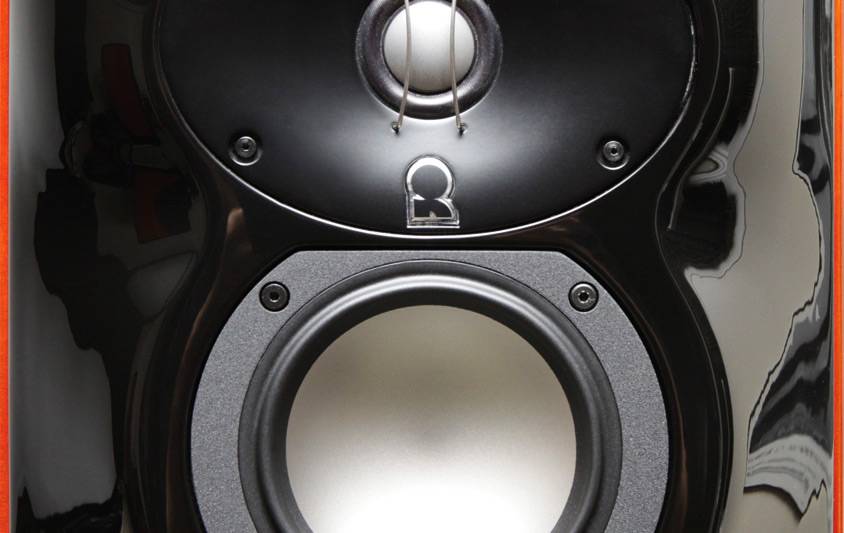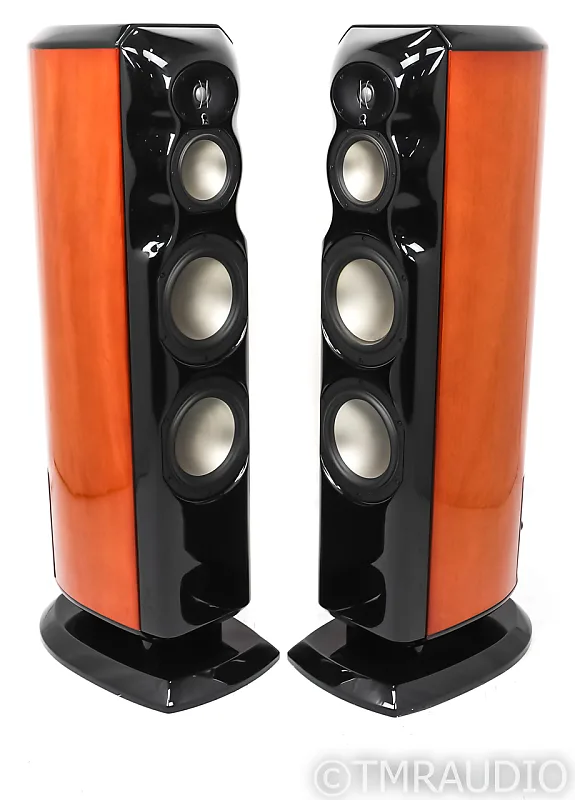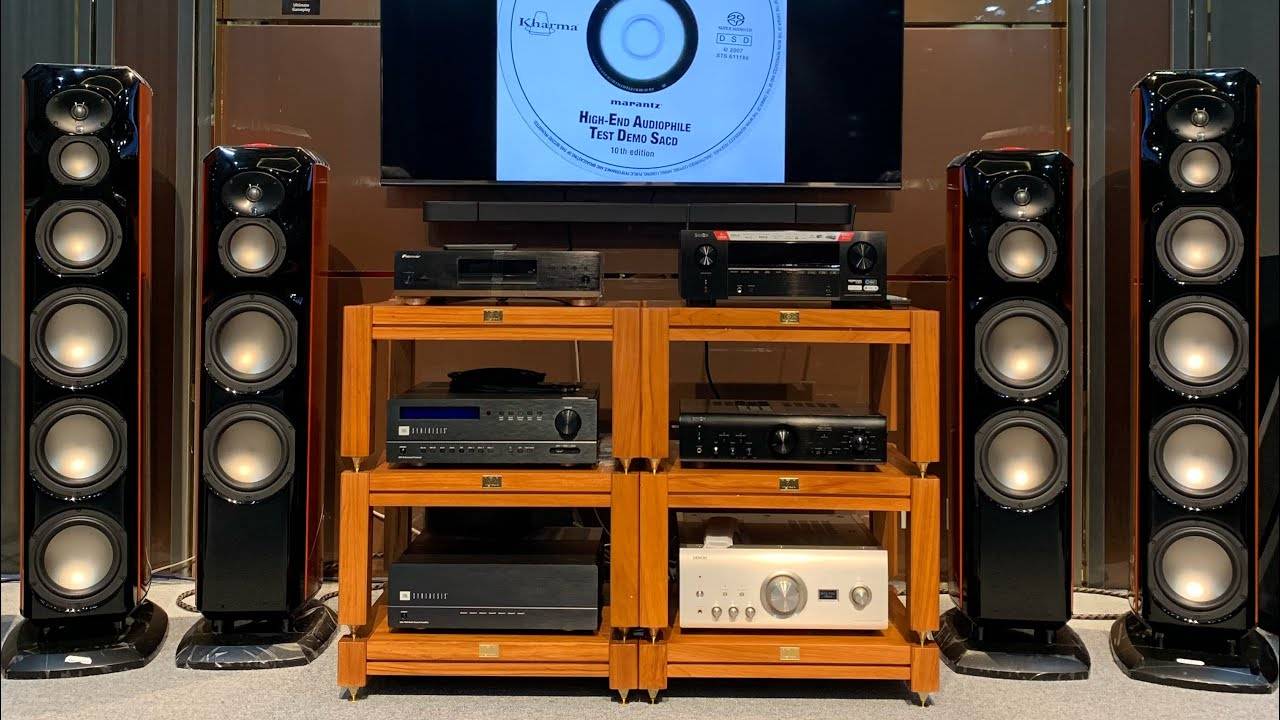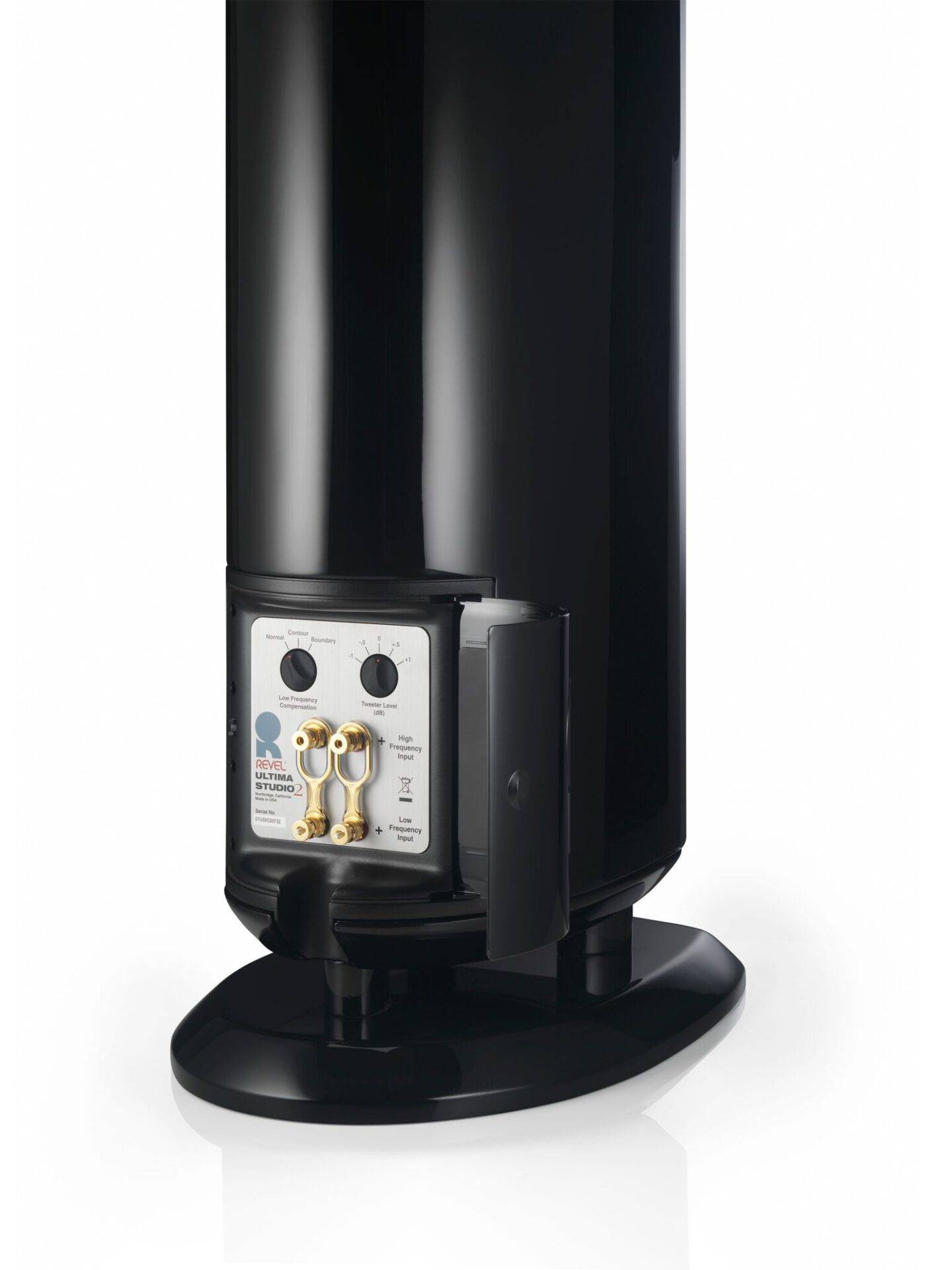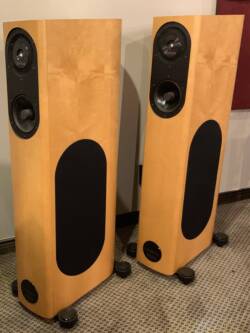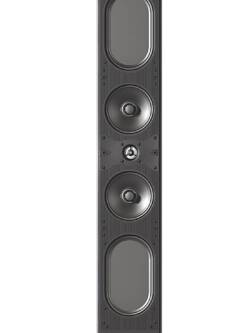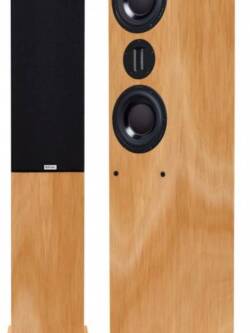Revel Ultima Studio2 Stereo Speakers
Original price was: R280,000.00.R112,000.00Current price is: R112,000.00.
Revel Ultima Studio2 loudspeaker

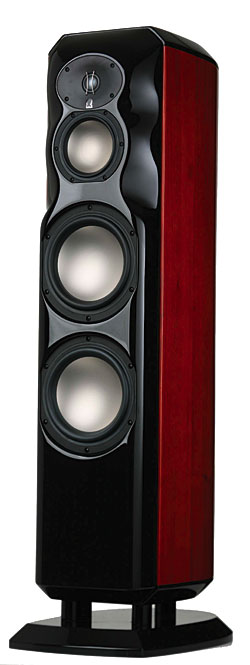 But when I saw the prototype of the Studio2 at the 2006 CEDIA Expo, I was somewhat deflated. Unlike the original Studio, which was assembled from separately formed bass and treble cabinets bound together by curved slab sides, the Studio2 lacked that unique appearance and seemed to be mere spare columns, albeit with gracefully curved sides and back. Still, the sound at the demo was exciting, and I immediately put in a request to get a review pair as soon as possible.
But when I saw the prototype of the Studio2 at the 2006 CEDIA Expo, I was somewhat deflated. Unlike the original Studio, which was assembled from separately formed bass and treble cabinets bound together by curved slab sides, the Studio2 lacked that unique appearance and seemed to be mere spare columns, albeit with gracefully curved sides and back. Still, the sound at the demo was exciting, and I immediately put in a request to get a review pair as soon as possible.
Things moved slowly, and they didn’t arrive till late 2007. Further delay in auditioning for this report resulted from one of the original pair having no tweeter output due to shipping damage, though the driver itself was functional.
See it now!
Although I had hoped my review samples of the Ultima Studio2 would be finished in glowingly rich mahogany, my pair was in a piano-black finish so perfectly glossy it looks almost like . . . plastic. This wasn’t helped by a door of actual plastic that matches the cabinet finish and covers the connection/control panel on the lower rear. I can understand that some people might prefer the terminal connections to be invisible, but to me it was only an obstruction. I have no other quibbles about the fit’n’finish of the Studio2, and its appearance, both in finish and in profile, grew on me the longer the pair of them stood in my living room. Still, it seems less impressive, as furniture, than a $16,000/pair speaker should be.
The Studio2 stands a bit taller than the original because the bass enclosure’s flared port is aimed downward into a space created by incorporating a nonremovable base. The advantage of this configuration is that the port’s output is more reliably predefined than if the port were on the front or rear. The Studio2 is also slimmer because great attention has been paid to creating a uniform in-room dispersion of sound. For example, the four drivers are set into a 21/2″-thick contoured front panel that virtually eliminates the edge diffractions of more rectangular boxes that make imaging unstable. The Studio2’s sides curve smoothly around to the rear—there are no sharp edges anywhere except at the bottom of the enclosure. To retain the virtues resulting from the smooth contours, the front grille fabric is stretched over a rigid frame that firmly attaches to the cabinet with magnets—no fixtures protrude to affect the dispersion even minimally.
The choice and implementation of each internal element continues the attention to detail seen in the cabinet. Beginning at the top, Revel uses a tweeter with a dome of pure beryllium. The tweeter is set in what looks like a shallow depression but is really a sophisticated waveguide. This ensures a uniform high-frequency dispersion that is independent of the frontal dimensions of the cabinet and more closely matches that of the midrange driver. It also permits the elimination of the original Studio’s rear-firing supplementary tweeter. In addition, the tweeter’s mechanical resonance has been reduced to below 600Hz, in part because of its highly compliant surround, which makes for an easier and superior crossover nearly two octaves higher.
The 5.5″ midrange driver and the two 8″ woofers have inverted-dome titanium diaphragms and neodymium magnet assemblies—a level of sophistication beyond that even of the midranges in the original Studio. The goal of using such lightweight but ultra-rigid diaphragms driven by powerful motors is to make these drivers store as little energy as possible, for excellent transient response. As in the original Studio, high-slope crossovers are used to minimize driver overlap, which in turn contributes to improved dispersion—an abiding theme.
Access to the connections and crossover is behind that little plastic back door, where you’ll find LF and HF terminals suitable for biwiring, a low-frequency compensation control, and a tweeter-level control. The LF control has settings of Normal (for when the speaker is 3′ or more from walls or large objects), Contour (to compensate for an unfortunate position with regard to room modes), and Boundary (for when the speaker is less than 2′ from a room boundary or large object). The tweeter-level control adjusts the highs to complement the general room acoustics. I needed neither adjustment in my room, though they did have subtle effects that I expect would be useful in more problematic rooms.
Hear it now!
Unpacking and setup were easy, as I’ve come to expect from Revel, although one new wrinkle is the need to remove the “eye patch” that protects the beryllium tweeter during shipping and handling. I biwired the Studio2s, for consistency and more out of habit than necessity, and placed them where the original Studios had sat. They seemed less sensitive than most speakers to small changes of position and angle, a consequence of their uniform dispersion. Still, they benefited, on a micro level, from a little tweaking; I ended up with them about 1′ closer to each other than the Mk.1 Studios, and with less toe-in than with most speakers. The grille made no noticeable difference in the overall balance or HF level. With the grille off, and unless I put my ear within an inch or two of the tweeter or woofer, all the sound seemed to come from the midrange driver, regardless of the frequencies involved. That’s great matching and integration of the drive-units.
My usual practice with a new speaker is to play it constantly but not pay too close attention to it: I turn on the radio or pop in CDs while I go about the other businesses of my life, and wait for a few weeks before I sit down to focus on critical listening. What usually happens is that, by then, the speaker has told me a lot by calling my attention to the things that stick out—usually, not good things.
After a week or two, the only thing I’d noticed about the Studio2 was a recurring impression, in the listening room or in an adjacent one, that the bass had unusual impact and clarity. Thus, when I sat down to listen carefully, I expected to find the bass a little overripe, or underlined by a fortuitous room mode. Not so. The Studio2’s bass and midbass were clean and audibly flat. Moving the speakers a foot to the left or right made no difference, which exonerated my room of being a mode-mongering culprit. It was simply that the Studio2 was capable of bass much like that of a well-designed, well-placed, properly EQ’d subwoofer.
The midbass, as evinced by bowed double bass, cello, or deep male voice, was clean and well-defined enough that, when a good, truly low sound came along, it had pop and impact untouched by muddiness. I can’t fathom how Revel has managed this, but this is the only speaker, the original Studio and the big B&Ws , included, to have such excellent bottom-end extension and definition—except for the JL Audio Fathom f113 subwoofer. This observation set the tone for the rest of my assessments.
For me, the most important performance parameters for a speaker are accuracy of voices, a deep and detailed soundstage, a wide dynamic range, and consistency of presentation. Reproducing voices, the Studio2 was simply ravishing. Male voices, particularly low ones, benefited greatly from the lack of spurious resonances and, in my room, superimposed room effects. Take, for example, It’s Now or Never, the recent homage to Elvis Presley by Robert Gordon and Chris Spedding (CD, Rykodisc RCD 10915). At times, Gordon sounds just like Elvis; at others, just like himself. The clarity of the Studio2 revealed those subtle transitions and let me really enjoy the humor of the gesture.
Female and massed voices were presented without glare but with exquisite detail. Rachmaninoff’s The Bells, in a recent recording by Semyon Bychkov and the Cologne West German Radio Orchestra (SACD/CD, Profil PH07028), is a perfect demo not only of excellent recording of voices, but also of how the Studio2s placed each voice, solo or ensemble, in a clear and proper position in a deep and defined soundstage. Soloists were up front with the orchestra, choral voices above and behind. Sometimes, the Studio2s stripped away the familiar warmth and immersion, as with that familiar demo track by Chris Jones, “No Sanctuary Here,” from Road Houses and Automobiles (CD, Stockfisch SFR 357.6027.2). Through most systems, including those at audio shows (!), Jones sounds frighteningly close-up, and the choral backup looms large. Through the Studio2s, Jones and the guys were human but retained the presence and intensity that underlie the song’s impact.
As for dynamic range and consistency, the Studio2 trumped here, too. I could turn up the volume with any recording, and at no level that I can countenance in a domestic setting did the character of the sound change. That doesn’t grant license to listen to a harpsichord at 110dB—a harpsichord sounds like a real harpsichord only at lower SPLs. On the other hand, if the music has a wide dynamic span, such as Rachmaninoff’s The Bells or its discmate, his Symphonic Dances, I could play it through the Studio2s at truly realistic levels, from quiet bell imitations to explosive symphonic bursts, while maintaining the illusion of a single performance event.
Rereading what I’ve written, I see that I haven’t mentioned the high-frequency range. That’s telling. Over the months that the Studio2 was my main conduit to the music, the treble range was remarkably unremarkable. When I listened to upper strings, brass, and percussion, they sounded just right. There was never anything to make me wince because of excess of high frequencies, or wonder because of a lack. The lovely recording of Mozart’s Violin Concertos 3–5 by violinist Marianne Thorsen, with conductor Oyvind Gimse and the Trondheim Soloists (SACD/CD, 2L 38SACD), let me hear the instrument in all its brilliance but with no superimposed edginess. Equally impressive was the magnificent Brass, by the Concertgebouw Brass Ensemble (SACD/CD, RCO Live 07002): the Studio2 delivered a truly glorious, powerful sound that retained the squillo (ringing) without biting off my ears.
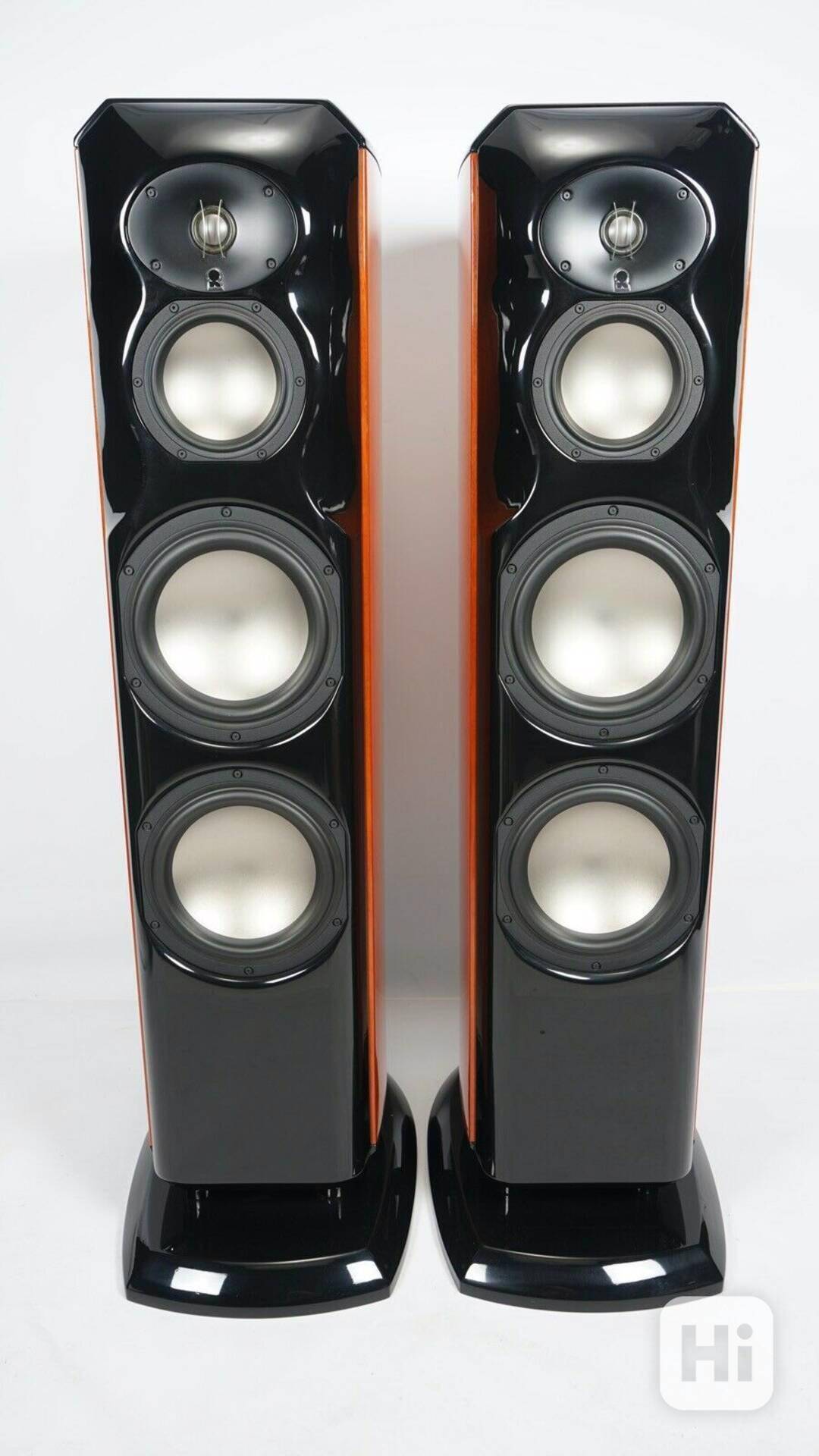
Context means nothing
The Studio2 wasn’t particularly sensitive to amplification but did let me hear back into the reproduction chain. Whether driven by the Classé D-3200, the Mark Levinson No.433, or the Bel Canto eVo 1000s, the Studio2s did just fine in all aspects. The No.433 produced a bit of rocky hardness in the extreme bass that could be quite impressive. The Classé was more generous and rich in the bass and excelled with the lower strings. The eVos seemed more neutral than either, but lacked the sweetness of the others in the upper reaches. All left the power, transparency, and soundstaging of the Studio2s untouched.
When I compared the Studio2 with the B&W 802D, the Revel seemed a contralto, the B&W a mezzo-soprano. By a tiny increment, I hear the midrange clearer and with greater presence through the B&W, while the Revel’s midrange was less individuated and more integrated with the midbass. Similarly, the Revel seemed to make more of distinctions at the very bottom of the audioband, while the B&Ws seem smoother. The treble was a tossup. As for soundstaging, both pairs threw a deep, well-defined soundstage, but the B&Ws make it a bit wider in my room. These comments apply only to two-channel performance; it’s hard to predict how a five-channel Revel Ultima2 system might stack up against my resident B&W array—but I’d love to find out.
Conclusions
What’s not to like—indeed, love—about the Revel Ultima Studio2? Almost nothing. I could point to the flimsy trap door and the less-than-overwhelming soundstage spread, though the latter was probably particular to my room. In the areas of lack of coloration, integration across the audioband, dynamic range, imaging, and soundstage depth, the Studio2s were simply outstanding. Including electrostatics that can’t approach the SPLs that the Revels handled with aplomb, the Ultima Studio2s imposed less of a fingerprint on the sound than any speaker I have used. Urgently recommended, both to those in the market and to those who simply want to hear how good a loudspeaker can be.
Mama said you only get one chance to make a first impression. That is certainly true by Alan Silverman for a loudspeaker, and I expect I’ll never forget the startling experience of hearing Revel’s Ultima Studio2 loudspeakers in my mastering room for the first time. [For the uninitiated, Revel is a Harman-owned company alongside pro audio industry stalwarts AKG, BSS, Crown, dbx, DigiTech, JBL, Lexicon, Soundcraft, Studer, et al. — Ed.]
As a reminder (and a validation) ever since that day, there has been a steady stream of visitors to Arf! Mastering to hear these new monitors. My current hobby is watching the expressions on the faces of listeners, then jotting down their initial comments. Usually it doesn’t take longer than a few seconds for the wide smiles and remarks to materialize. These include “amazing,” “the musicians are here,” and the popular “Wow. Wow. WOW!” Another good one: “I never want to get up from this chair.” Finally, after one listening session, an engineer from a major NYC mastering house posted succinctly on a mastering forum, “OMG!”
In all my years traipsing through studios, high-end dealerships and homes with elaborate stereo systems, I can confidently say that this, the Ultima Studio2 speaker, is markedly different. It all starts with Revel chief designer Kevin Voecks, no beginner to speaker design, who has done influential work at high-end loudspeaker companies Mirage (Klipsch Group) and Snell (THX pioneer, formerly of D&M Holdings). He was brought to Harman International to start up Revel, a brand specifically intended for the highest end of the loudspeaker market. This led to a synergy of comprehensive manufacturing resources (Harman) and dedication to making the finest speakers possible (Voecks himself).
Also important to the Revel story: on board at Harman were Dr. Floyd Toole and Sean Olive, two scientists who championed the idea that speakers should be tested for listener preference under double-blind conditions. For Revel prototypes, this was accomplished in Harman’s Multi-channel Listening Lab (MLL) where speakers — hidden behind an acoustically transparent curtain — can be shuffled in and out of position on pneumatic rails, and in under four seconds; such a unique evaluation environment allows speaker-to-speaker comparison from the same position within the natural timeframe of aural memory.
As a result, large numbers of listeners blind-auditioned Harman prototypes alongside competitors’ finished products, leading to some surprising findings. First, listener preference often had no correlation with price. Second, expert listeners and casual listeners heard things in very much the same way. Further work at the lab led to the discovery of which parameters result in the highest listener preference scores. These turned out to be a linear frequency response, low distortion, low resonance and an even dispersion of sound within at least 60 degrees of center. Revel’s Ultima2 Series uses these discoveries as a basis of design and purpose.
Revel Ultima Studio2 review
Features
Each Ultima2 Studio2 loudspeaker stands 46 inches high by 14 inches wide and weighs 140 pounds. It is a three-way system in a beautifully finished, nine-layer MDF cabinet with a gracefully curved back and a downward firing flared port. The in-house designed driver set consists of a 5.5-inch midrange driver and two 8-inch woofers, all with inverted-dome titanium diaphragms and neodymium magnet assemblies and a one-inch beryllium tweeter. The system achieves a remarkably linear response in the listening window of +/-1 dB from 33 Hz to 20 kHz. Adjustments consist of +/-1 dB for the tweeter in .5 dB steps and a contour control for the LF drivers to aid in matching the system to room boundaries. Each system is individually tuned to match the laboratory prototype’s specs to within “a fraction of a decibel” before leaving the factory.
Revel Ultima Studio2 In Use
To be completely forthcoming, I should probably have my head examined for agreeing to review a new pair of speakers in a busy mastering room; since a mastering engineer depends on knowledge of his/her room, a new set of monitors is nothing less than an altered state of consciousness. I only agreed to bring in the speakers at the urging of Michael Chafee, a dedicated music and sound enthusiast and, in my opinion, one of the most talented room tuners and designers of high-end audio systems in the industry. When Mike says, “You’ve got to hear something,” it’s time to clear your schedule (and hide your checkbook). The timing was right — there was a lull in the schedule around last year’s winter holidays — and the speakers arrived. But I wasn’t prepared for what happened next.
As I listened to my usual references and past work, I experienced an unsettling feeling: that I’d never really heard any of it before. These speakers literally vanished, leaving only the music in exciting detail.
With the Ultima Studio2 loudspeakers, the full range of sound is presented, from the deepest lows to the highest highs, with nothing out of proportion. Tonality, texture, resolution and imaging are breathtaking and effortless, yet there is nothing clinical here — the Revels produce a stunning musical picture. As I listened through a long list of mastered and un-mastered sources, it became evident that they weren’t flattering, either; flaws and defects in mixes were plainly evident. From classical to heavy metal, the Revels sailed through any genre that I could throw at them.
Over time, the Studio2s literally re-educated my ears. In comparison, my former reference speakers sounded smeared, colored and synthetic. The old monitors — familiar to many mastering rooms — came to the fore and got in the way of the music. Using the Revels, not only was I rediscovering my favorite music, I was rediscovering my own gear, some of which had been with me for over a decade. The speakers gave me far more control and precision over my work than ever before. So, watch what you do with those knobs or the Studio2s will dope-slap you.
Invariably, the most critical question for a mastering engineer is, “How does your work translate to the outside world?” Via Revel, the test masters I took home sounded “righter” than in the past; sometimes it was a subtle difference, but there was always definitely a difference. I worked the Revels into my workflow until they became my sole monitors (and out came the checkbook). Reactions from clients have been consistently positive, and sometimes emotional, to a high degree. The greatly enhanced client experience in the room has been a constant source of pride and satisfaction for me.
Summary
The combined precision, sensitivity and sheer sonic beauty of the Revel Ultima Studio2 has changed my conception of what is possible for a loudspeaker. They have become a formidable advantage in my mastering room. Are they worth the $15,999 list price? Well, considering that many mid-level to high-level mastering rooms already have at least $20k invested in high-end converters, preamps and amplifiers in the monitor chain, to add less than that again to pull it all together and raise the bar to the such a high level of quality and accuracy in one swoop is money well spent, in my opinion. With the Studio2s, there’s simply no fluff here. You get gorgeous and accurate sound, wonderful client reactions, improved workflow and an aesthetically handsome set of speakers for your investment. It doesn’t get any better, or pay off any better, than that.
Price: $15,999 list, per pair
Description
Specifications
Description:
Three-way bottom-ported, floor-standing loudspeaker.
Drive-units:
1″ beryllium-dome tweeter in waveguide front plate,
5.5″ inverted titanium-dome midrange driver,
two 8″ inverted titanium-dome woofers.
Crossover frequencies: 230Hz, 2kHz.
Anechoic frequency response: 32Hz–45kHz, –3dB.
Frequency response on axis: 33Hz–20kHz, ±1dB.
In-room response relative to target response: 31Hz–18kHz, ±0.5dB.
Low-frequency extension: –10dB at 21Hz, –6dB at 25Hz, –3dB at 32Hz.
Impedance: 6 ohms nominal, 3.7 ohms minimum.
Sensitivity: 88.7dB/2.83V/m (2 pi anechoic).
Dimensions: 46.25″ (1175mm) H by 13.75″ (349mm) W by 20.5″ (521mm) D, all including nonremovable base. Shipping weight: 140 lbs (63.5kg).
Finish: Black or mahogany, both high-gloss.
Serial Numbers Of Units Reviewed: 20143, 20144.
Price: $15,999/pair

